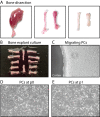Mouse Periosteal Cell Culture, in vitro Differentiation, and in vivo Transplantationin Tibial Fractures
- PMID: 34458401
- PMCID: PMC8376579
- DOI: 10.21769/BioProtoc.4107
Mouse Periosteal Cell Culture, in vitro Differentiation, and in vivo Transplantationin Tibial Fractures
Abstract
The periosteum covering the outer surface of bone contains skeletal stem/progenitor cells that can efficiently form cartilage and bone during bone repair. Several methods have been described to isolate periosteal cells based on bone scraping and/or enzymatic digestion. Here, we describe an explant culture method to isolate periosteum-derived stem/progenitor cells for subsequent in vitro and in vivo analyses. Periosteal cells (PCs) isolated using this protocol express mesenchymal markers, can be expanded in vitro, and exhibit high regenerative potential after in vivo transplantation at a fracture site, suggesting that this protocol can be employed for PC production to use in new cell-based therapies.
Keywords: Bone regeneration; In vitro differentiation; In vivo cell transplantation; Periosteum; Skeletal stem/progenitor cell.
Copyright © 2021 The Authors; exclusive licensee Bio-protocol LLC.
Conflict of interest statement
Competing interestsThe authors declare no competing interests.
Figures




References
-
- Brownlow H. C., Reed A., Joyner C., Simpson A.H.(2000). Anatomical effects of periosteal elevation. J Orthop Res 18(3): 500-502. - PubMed
-
- Debnath S., Yallowitz A.R., McCormick J., Lalani S., Zhang T., Xu R., Li N., Liu Y. F., Yang Y. S., Eiseman M., Shim J. H., Hameed M., Healey J. H., Bostrom M. P., Landau D. A., Greenblatt M. B.(2018). Discovery of a periosteal stem cell mediating intramembranous bone formation. Nature 562(7725): 133-139. - PMC - PubMed
Grants and funding
LinkOut - more resources
Full Text Sources

